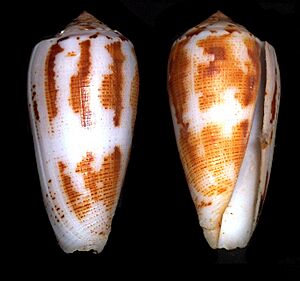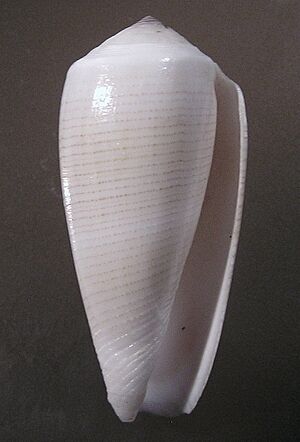Conus magus facts for kids
Quick facts for kids Conus magus |
|
|---|---|
 |
|
| Dorsal (left) and ventral (right) views of a shell of Conus magus | |
| Conservation status | |
| Scientific classification | |
| Synonyms | |
|
Conus magus, often called the magical cone snail, is a type of sea snail. It is a marine gastropod mollusk that belongs to the Conidae family. This family includes all the amazing cone snails.
Like all species in the Conus group, these snails are predatory. This means they hunt and eat other sea creatures. They are also venomous. Their venom contains special chemicals called conotoxins. These chemicals have strong effects on the nervous system. Because they can "sting" humans, it is very important to be careful with live cone shells. It is best not to touch them at all.
The variety Conus magus var. decurtatus Dautzenberg, 1910 is actually another name for Conus striolatus Kiener, 1848.
About the Magical Cone Snail
The shell of an adult magical cone snail can be between 16 mm and 94 mm long. That's about the size of a small button to a large thumb! This common snail has shells that vary a lot in pattern and color. This is why it has been given many different scientific names over time.
The shell has a moderate spire, which is the pointed top part. This spire has thin lines on it. The main part of the shell, called the body whorl, is long and shaped like a cylinder. It also has thin lines near the bottom. The shell's color can be white, bluish-gray, orange-brown, or dark brown. It often has thin, broken lines of dark brown all around it. These lines can sometimes look like dots. The middle of the main shell part often has an uneven white band. The spire also has a checkerboard pattern of dark brown.
How Venom Helps People
A chemical called Ziconotide comes from the toxin of the Conus magus snail. This chemical is a very strong painkiller. Dr. Baldomero Olivera at the University of Utah first discovered it.
Scientists developed Ziconotide to help people with very bad, long-lasting pain. This pain can be caused by conditions like AIDS, cancer, or problems with the nervous system. In December 2004, the U.S. Food and Drug Administration approved it under the name Prialt.
Ziconotide works by blocking certain channels in nerve cells that send pain signals. This stops the pain signals from reaching the brain. It is given to patients through an injection into the spinal fluid.
Where Magical Cone Snails Live
These marine snails live in the Red Sea and the Indian Ocean. You can find them off the coast of Madagascar and in the Mascarene Basin. They also live across a large area of the Pacific Ocean. This includes places from Indonesia to Japan, and stretching to the Marshall Islands, Wallis and Futuna, and Fiji. They are mostly found around the Philippines and off Queensland, Australia.
Gallery







